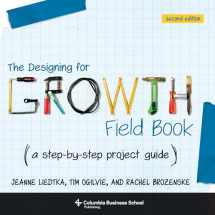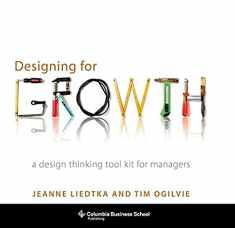
The Designing for Growth Field Book: A Step-by-Step Project Guide (Columbia Business School Publishing)
ISBN-13:
9780231187893
ISBN-10:
0231187890
Edition:
second edition
Author:
Jeanne Liedtka, Tim Ogilvie
Publication date:
2019
Publisher:
Columbia Business School Publishing
Format:
Paperback
152 pages
Category:
Industrial & Product Design
,
Decorative Arts & Design
,
Decision-Making & Problem Solving
,
Management & Leadership
,
Management
,
Management Science
,
Systems & Planning
,
Strategy & Competition
,
Entrepreneurship
,
Small Business & Entrepreneurship
,
Strategic Planning
,
Processes & Infrastructure
,
Decision Making
,
Business Skills
FREE US shipping
on ALL non-marketplace orders
Marketplace
from $17.14
USD
Marketplace offers
Seller
Condition
Note
Seller
Condition
New
Brand New! Not overstocks! Brand New direct from the publisher! Ships in sturdy cardboard packaging.
Book details
ISBN-13:
9780231187893
ISBN-10:
0231187890
Edition:
second edition
Author:
Jeanne Liedtka, Tim Ogilvie
Publication date:
2019
Publisher:
Columbia Business School Publishing
Format:
Paperback
152 pages
Category:
Industrial & Product Design
,
Decorative Arts & Design
,
Decision-Making & Problem Solving
,
Management & Leadership
,
Management
,
Management Science
,
Systems & Planning
,
Strategy & Competition
,
Entrepreneurship
,
Small Business & Entrepreneurship
,
Strategic Planning
,
Processes & Infrastructure
,
Decision Making
,
Business Skills
Summary
The Designing for Growth Field Book: A Step-by-Step Project Guide (Columbia Business School Publishing) (ISBN-13: 9780231187893 and ISBN-10: 0231187890), written by authors
Jeanne Liedtka, Tim Ogilvie, was published by Columbia Business School Publishing in 2019.
With an overall rating of 3.8 stars, it's a notable title among other
Industrial & Product Design
(Decorative Arts & Design, Decision-Making & Problem Solving, Management & Leadership, Management, Management Science, Systems & Planning, Strategy & Competition, Entrepreneurship, Small Business & Entrepreneurship, Strategic Planning, Processes & Infrastructure, Decision Making, Business Skills) books. You can easily purchase or rent The Designing for Growth Field Book: A Step-by-Step Project Guide (Columbia Business School Publishing) (Paperback) from BooksRun,
along with many other new and used
Industrial & Product Design
books
and textbooks.
And, if you're looking to sell your copy, our current buyback offer is $1.32.
Description
Designing for Growth: A Design Thinking Tool Kit for Managers (D4G) showed how organizations can use design thinking to boost innovation and drive growth. This updated and expanded companion guide is a stand-alone project workbook that provides a step-by-step framework for applying the D4G tool kit and process to a particular project, systematically explaining how to address the four key questions of the design thinking approach.
In the field book, Jeanne Liedtka, Tim Ogilvie, and Rachel Brozenske guide readers through the design process with reminders of key D4G takeaways as they progress. Readers learn to identify an opportunity, draft a design brief, conduct research, establish design criteria, brainstorm, develop concepts, create napkin pitches, make prototypes, solicit feedback from stakeholders, and run learning launches. This second edition is suitable for projects in business, nonprofit, and government contexts, with all-new tools, practical advice, and facilitation tips. A new introduction discusses the relationship between strategy and design thinking.
In the field book, Jeanne Liedtka, Tim Ogilvie, and Rachel Brozenske guide readers through the design process with reminders of key D4G takeaways as they progress. Readers learn to identify an opportunity, draft a design brief, conduct research, establish design criteria, brainstorm, develop concepts, create napkin pitches, make prototypes, solicit feedback from stakeholders, and run learning launches. This second edition is suitable for projects in business, nonprofit, and government contexts, with all-new tools, practical advice, and facilitation tips. A new introduction discusses the relationship between strategy and design thinking.


We would LOVE it if you could help us and other readers by reviewing the book
Book review

Congratulations! We have received your book review.
{user}
{createdAt}
by {truncated_author}




